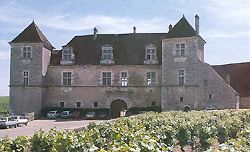Le
Clos de Vougeot

On Christmas Day, 1098, nine months after the community arrived at Cîteaux, the monks received from the duke of Burgundy a vineyard near the Château de Meursault. A few years later, Gaudri de Chambolle presented the abbey with another vineyard, contiguous with this towards the north, and Hugues le Blanc de Vergy another which joined it in the south. These donations were followed by others at Aloxe, at Corton and Les Petits-Musigny. By the middle of the twelfth century some of the great names of the Côte d'Or were already in the hands of the Cistercians and the extensive vineyard of Clos de Vougeot had been established. In 1164 a papal bull, issued by Alexander III, placed the abbey of Cîteaux and its vineyard under the protection of the Holy See.
The
group of buildings which go to make up the Clos de Vougeot are among the
most attractive and interesting examples of architecture in Burgundy.
Both the cuverie -a cloister in which
the pressing and vinification took place- and the cellar
belong to the twelfth and thirteenth centuries. They are severely but
beautifully functional. The château, in which Jean Loisier, forty-eighth
abbot of Cîteaux, entertained his more important guests, dates from
the Renaissance and is a fine example of its style.
Nothing could be more impressive than the enormous
presses situated in the corners of the cuverie. It would be
perfectly possible to make wine here today.


For centuries Clos Vougeot (so spelt when it means the wine) was considered
the finest of all burgundies. In 1371 thirty hogsheads (some 228 litres
or 50 gallons) of it were sent to Rome to celebrate the election of Pope
Gregory XI. Three years later the abbot who sent the gift was made a cardinal.
